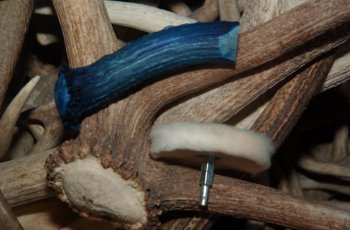DeerWrangler
New Member
I have been tinkering with knives for a few years but for the most part stuck with "This works so go with it" and that seems to work. BUT i have wanted to dyed antler handles that if done properly SHOULD look a whole lot like Stabilized giraffe bone but without the sheen that is common in stabilizing..
YES a lot of people seem to use PP and that does work BUT??
I have light acid dipped, cleaned and then used a stabilizer & mixed dye with it and then used a vac chamber. It does work more or less but again the stabilizer itself makes the antler plastic looking
The best results have been to use older weathered antler that has stress marks ( hairline cracks). Clean and rough sand the surface to remove much of the very outer weathered chalk layer to bring out the stress marks. ( I pre sand the areas where the handle will butt u to the guard and on hidden tang do all the drilling etc) Wipe down with alcohol.
I then place it in a jar of leather dye that has been diluted with acetone and let soak for a few days. Soaking for an extended period allows the dye to soak deeper into the antler....... Leather dye alone seems to just dye the surface but does not penetrate deep. The acetone seems to allow (reasons unknown) the dye to penetrate deeper.
Once the antler has been removed from dye and dried "NOW COMES" my problem.
The antler looks great but even with sanding etc some of the dye wants to rub off on hands and i am unsure of how best to prevent that without applying a sealer that WILL make the antler look plastic / acrylic. ANY suggestion as to what i do now?
There is a soak stabilizer that they use on pool ques called nelsonite that leaves the the base material a more natural look. But i have not tried it nor so i know how deep it would soak into the antler or IF it could carry the dye ( leather dye, reactive or alkaline based).
Anyone got any ideas
YES a lot of people seem to use PP and that does work BUT??
I have light acid dipped, cleaned and then used a stabilizer & mixed dye with it and then used a vac chamber. It does work more or less but again the stabilizer itself makes the antler plastic looking
The best results have been to use older weathered antler that has stress marks ( hairline cracks). Clean and rough sand the surface to remove much of the very outer weathered chalk layer to bring out the stress marks. ( I pre sand the areas where the handle will butt u to the guard and on hidden tang do all the drilling etc) Wipe down with alcohol.
I then place it in a jar of leather dye that has been diluted with acetone and let soak for a few days. Soaking for an extended period allows the dye to soak deeper into the antler....... Leather dye alone seems to just dye the surface but does not penetrate deep. The acetone seems to allow (reasons unknown) the dye to penetrate deeper.
Once the antler has been removed from dye and dried "NOW COMES" my problem.
The antler looks great but even with sanding etc some of the dye wants to rub off on hands and i am unsure of how best to prevent that without applying a sealer that WILL make the antler look plastic / acrylic. ANY suggestion as to what i do now?
There is a soak stabilizer that they use on pool ques called nelsonite that leaves the the base material a more natural look. But i have not tried it nor so i know how deep it would soak into the antler or IF it could carry the dye ( leather dye, reactive or alkaline based).
Anyone got any ideas


